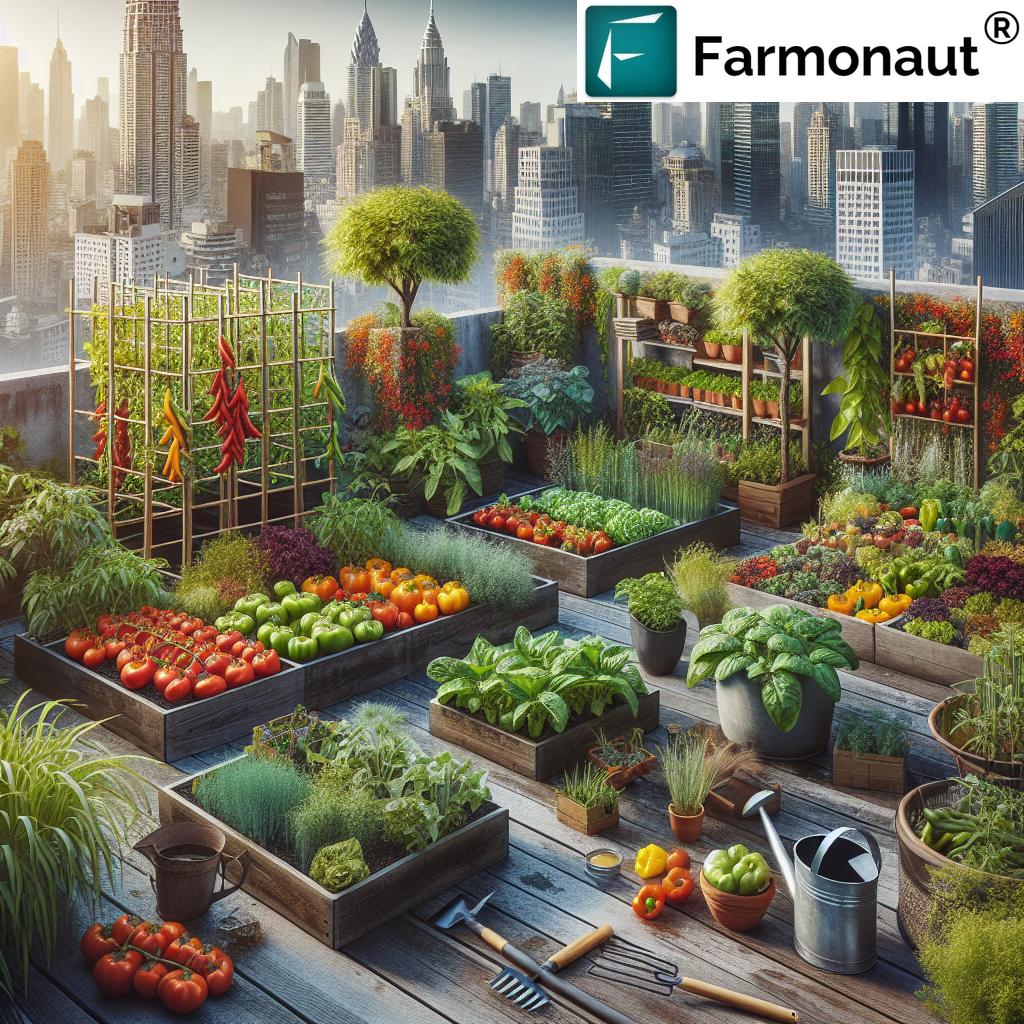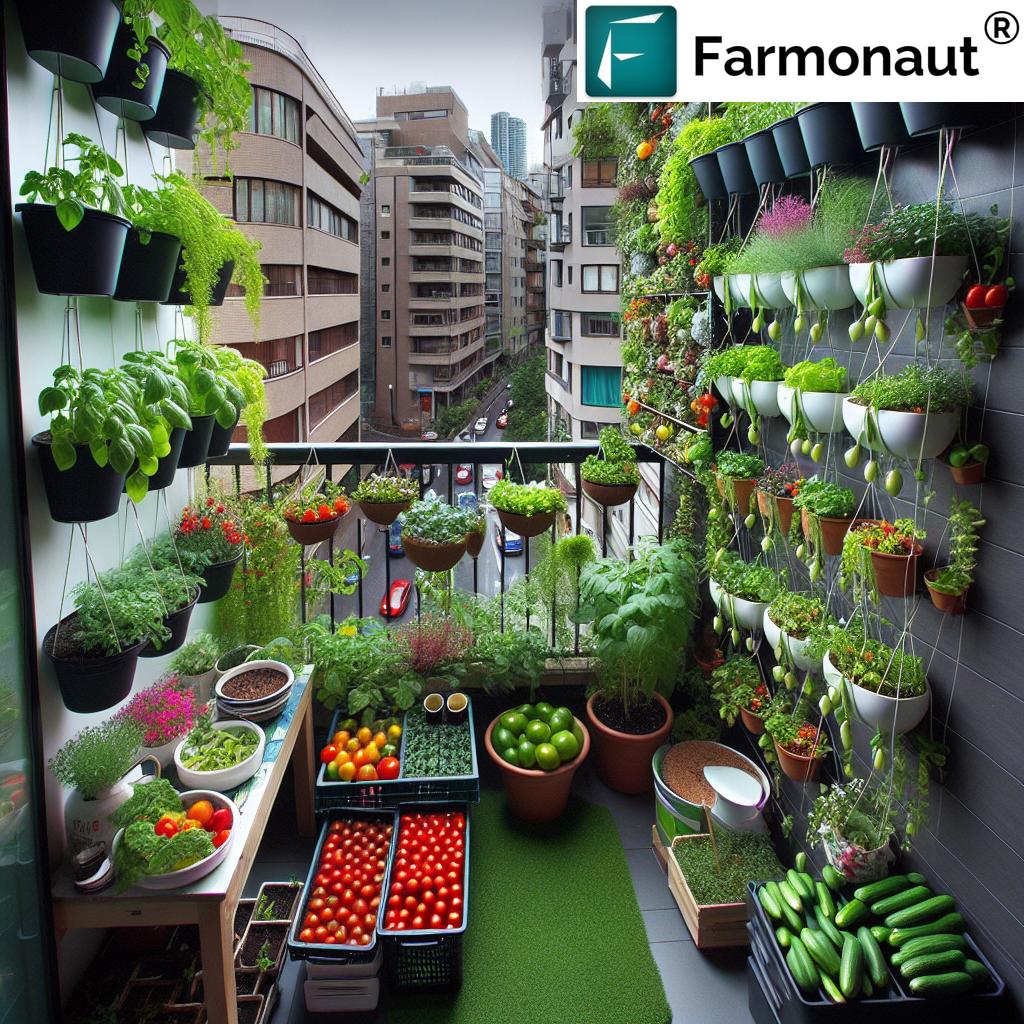Urban Gardening 101: A Beginner’s Guide to Growing Vegetables in Chicago’s City Spaces
CHICAGO — Since 1837, Chicago has been known as an “Urbs in Horto” — a “city in a garden.” While much has changed over the past 190 years, Chicago’s agricultural roots remain deeply ingrained. Today, we’re embarking on a journey to discover the art of urban gardening in the Windy City, transforming concrete jungles into thriving green oases.

“Chicago’s urban gardeners can extend the growing season by up to 6 weeks using raised beds and container gardening techniques.”
In this comprehensive guide, we’ll explore everything you need to know about starting your own “Hortus in Urbe” – garden in the city. From selecting the perfect space to mastering container gardening and raised bed techniques, we’ve got you covered. Whether you’re a beginner or an experienced gardener, you’ll find valuable tips on choosing the best plants for Chicago’s climate, harvesting homegrown produce, and overcoming challenges unique to city gardening.
Getting Started: Location, Location, Location
The first crucial step in urban gardening is determining your growing space. As Natasha Nicholes, executive director of We Sow We Grow, an agricultural nonprofit in West Pullman, points out, “We want people to start with the space that they can manage.” Consider these options:
- Balcony or patio for container gardening
- Raised beds in nearby parks or rooftops
- Yard space for in-ground gardening
The available space will guide your plant selection and gardening approach. Remember, some plants require more sun and warmth, while others prefer cooler, shady spots. Crops like corn, raspberries, and tomatoes need more space, while carrots, radishes, and herbs can be planted more tightly.
Choosing Your Garden Type
Once you’ve identified your space, it’s time to decide on the type of garden you’ll cultivate. Here are the main options for urban gardeners in Chicago:
1. In-Ground Gardening
If you’re lucky enough to have yard space, in-ground gardening is a classic option. It offers the most room for roots to grow and often provides the largest growing area. However, be mindful of local wildlife like rabbits and squirrels – you may need to incorporate fencing or netting to protect your crops.
2. Raised Bed Gardening
Raised beds are an excellent compromise between in-ground and container gardening. They offer better soil control, improved drainage, and can be easier on your back. Raised beds are perfect for small spaces and can even be placed on concrete surfaces.
3. Container Gardening
For those with limited space, container gardening is the way to go. Balconies, stoops, and even windowsills can become productive growing spaces. Many plants, including tomatoes, peppers, and herbs, thrive in containers.
Understanding Chicago’s Growing Season
Chicago’s growing season typically runs from April or May to October, depending on the crop. As urban gardeners, we need to be aware of the USDA Hardiness Zones for our area – Chicago falls within Zones 6a and 6b. This information is crucial when selecting plants that can withstand our climate.
Pro Tip: To extend your growing season, consider using raised beds or container gardens. These warm up faster in spring and can be protected more easily from early fall frosts.
Soil Preparation: The Foundation of Your Garden
Regardless of your garden type, proper soil preparation is key to success. Here’s what you need to know:
- In-ground gardens: Clear the area of debris, loosen the soil, and consider adding compost and fertilizer.
- Raised beds: Fill with a mix of topsoil, compost, and other organic matter.
- Containers: Use a high-quality potting mix designed for container gardening.
Remember to test your soil, especially for in-ground gardens, to ensure it’s safe and suitable for growing edible plants.
Essential Tools for Urban Gardening
Every urban gardener needs a basic toolkit. Here are some essentials:
- Gloves
- Trowel
- Pruning shears
- Watering can or hose
- Hand fork
- Rake (for larger spaces)
Farmonaut Tip: While physical tools are important, don’t forget about digital tools that can enhance your gardening experience. Farmonaut’s mobile app offers valuable insights for urban gardeners, including weather forecasts and plant health monitoring.


Choosing the Right Plants for Chicago
When selecting plants for your Chicago urban garden, consider these factors:
- Hardiness Zone compatibility (6a and 6b)
- Available space
- Sunlight exposure
- Personal preferences and culinary needs
Here’s a table of some top vegetables for Chicago urban gardens:
| Vegetable Name | Growing Season | Space Requirements | Sunlight Needs | Difficulty Level |
|---|---|---|---|---|
| Tomatoes | Late May to Early October | 2-3 sq ft per plant | Full Sun | Moderate |
| Lettuce | April to June, September to October | 4-6 inches apart | Partial Shade | Easy |
| Peppers | Late May to Early October | 1-2 sq ft per plant | Full Sun | Moderate |
| Kale | April to November | 12-18 inches apart | Full Sun to Partial Shade | Easy |
| Basil | May to September | 6-12 inches apart | Full Sun | Easy |
“Over 70% of Chicago’s urban gardens utilize companion planting strategies to maximize space and improve crop yields.”
Planting Techniques for Urban Gardens
Now that you’ve chosen your plants, it’s time to get them in the ground (or container). Here are some key techniques:
1. Starting Seeds Indoors
For many crops, starting seeds indoors can give you a head start on the growing season. This is especially useful for warm-season crops like tomatoes and peppers. Start these indoors in late March or early April, then transplant them outside after the last frost (typically around May 15 in Chicago).
2. Direct Sowing
Some plants, like root vegetables and leafy greens, prefer to be sown directly in the garden. Follow the instructions on your seed packets for depth and spacing.
3. Transplanting
When moving seedlings outdoors, be sure to “harden them off” by gradually exposing them to outdoor conditions over a week or two. This helps prevent transplant shock.
Companion Planting: Maximizing Your Urban Garden
Companion planting is a smart strategy for urban gardeners looking to make the most of limited space. This technique involves planting complementary crops together to improve growth, deter pests, and maximize yields. Here are some classic companion planting combinations:
- Tomatoes + Basil + Marigolds: Basil repels pests, while marigolds attract pollinators
- Carrots + Onions: Onions deter carrot flies
- Beans + Corn + Squash (The “Three Sisters”): A traditional Native American planting method
Farmonaut Insight: Our satellite-based crop health monitoring can help you track the success of your companion planting strategies. Learn more about our services here.
Watering and Maintenance
Proper watering is crucial for urban gardens, especially in containers which can dry out quickly. Here are some tips:
- Water deeply and less frequently to encourage deep root growth
- Water at the base of plants to avoid wetting leaves (which can lead to fungal diseases)
- Use mulch to retain moisture and suppress weeds
- Monitor your plants regularly for signs of pests or diseases
Pro Tip: Consider installing a drip irrigation system for consistent, efficient watering, especially if you have a larger garden or raised beds.
Harvesting Your Urban Bounty
The most rewarding part of urban gardening is harvesting your own fresh, homegrown produce. Here are some harvesting tips:
- Harvest in the morning when vegetables are at their freshest
- Pick vegetables when they’re young and tender for the best flavor
- Use clean, sharp tools to avoid damaging plants
- Harvest herbs regularly to encourage bushier growth
Remember, regular harvesting often encourages plants to produce more, so don’t be shy about picking your produce!
Overcoming Urban Gardening Challenges
Urban gardening in Chicago comes with its own set of challenges, but with the right strategies, you can overcome them:
- Limited Space: Utilize vertical gardening techniques, like trellises and hanging baskets
- Poor Soil: Build raised beds or use container gardens with high-quality potting mix
- Shade from Buildings: Choose shade-tolerant plants or use reflective surfaces to increase light
- Urban Pests: Use physical barriers and companion planting to deter pests
- Limited Time: Choose low-maintenance plants and consider automated watering systems
Farmonaut Tip: Our AI-driven advisory system can help you anticipate and address many common gardening challenges. Check out our app for personalized gardening advice.

Community Resources for Chicago Urban Gardeners
Chicago has a vibrant community of urban gardeners and numerous resources to support your gardening journey:
- Chicago Park District Community Gardens: Offers garden plots in parks across the city
- NeighborSpace: A non-profit urban land trust that preserves and supports community gardens
- Advocates for Urban Agriculture: Provides resources and advocacy for urban farming in Chicago
- Chicago Botanic Garden: Offers classes and workshops on various gardening topics
Remember, as Natasha Nicholes says, “It helps growing with a community.” Don’t hesitate to reach out to local gardening groups or join online forums to connect with fellow urban gardeners.
Embracing Technology in Urban Gardening
While urban gardening might seem like a hands-in-the-dirt activity, technology can play a significant role in improving your gardening success. Here’s how:
- Weather Apps: Use reliable weather apps to plan your watering and planting schedules
- Plant Identification Apps: Helpful for identifying unknown plants or weeds in your garden
- Garden Planning Software: Assists in designing your garden layout and tracking plant rotations
- Smart Irrigation Systems: Automate your watering based on weather conditions and plant needs
Farmonaut’s Contribution: Our platform offers advanced satellite-based monitoring and AI-driven insights to help urban gardeners make data-driven decisions. From tracking crop health to providing personalized advice, Farmonaut brings precision agriculture technology to city gardens. Explore how Farmonaut can enhance your urban gardening experience.
Conclusion: Your Urban Gardening Journey Begins
Urban gardening in Chicago is more than just a hobby – it’s a way to connect with nature, improve your health, and contribute to a more sustainable city. As you embark on your gardening journey, remember that every garden is unique, and there’s always something new to learn.
Whether you’re growing tomatoes on your balcony, herbs in your kitchen window, or a full vegetable plot in a community garden, you’re part of Chicago’s rich agricultural tradition. As Natasha Nicholes wisely says, “Nobody’s ever going to have the perfect garden. You gotta have fun.”
So grab your trowel, pick your seeds, and start growing. Your urban oasis awaits!
FAQs About Urban Gardening in Chicago
- When is the best time to start planting in Chicago?
For most vegetables, mid-May (after the last frost) is a good time to start planting outdoors. However, cool-season crops can be planted earlier, and many warm-season crops can be started indoors in March or April. - What vegetables grow best in Chicago’s climate?
Tomatoes, peppers, leafy greens, root vegetables, and many herbs thrive in Chicago. Refer to our table above for more specific recommendations. - How can I garden if I only have a small balcony?
Container gardening is perfect for small spaces. Use pots, hanging baskets, and vertical gardening techniques to maximize your space. - Is it safe to grow vegetables in urban soil?
It’s important to have your soil tested for contaminants before growing edibles in urban soil. Alternatively, use raised beds or containers with fresh potting mix. - How can I protect my garden from urban pests?
Use physical barriers like netting or fencing, practice companion planting, and keep your garden clean to deter pests. Natural deterrents like marigolds can also be helpful.
Earn With Farmonaut: Join our Affiliate Program
Earn 20% recurring commission with Farmonaut’s affiliate program by sharing your promo code and helping farmers save 10%. Onboard 10 Elite farmers monthly to earn a minimum of $148,000 annually—start now and grow your income!
Farmonaut Subscriptions
Ready to take your urban gardening to the next level? Explore Farmonaut’s subscription options above to access advanced satellite-based monitoring and AI-driven insights for your garden.
Happy gardening, Chicago!














Urban gardening is such a fantastic way to bring fresh produce to city spaces! With container gardening, raised beds, and vertical planters, even small areas can be transformed into thriving green spaces.